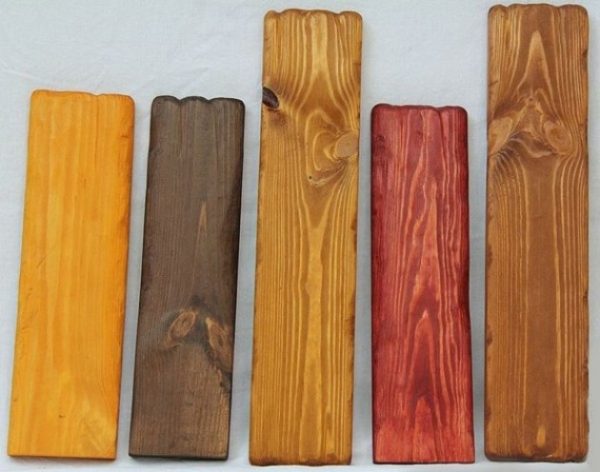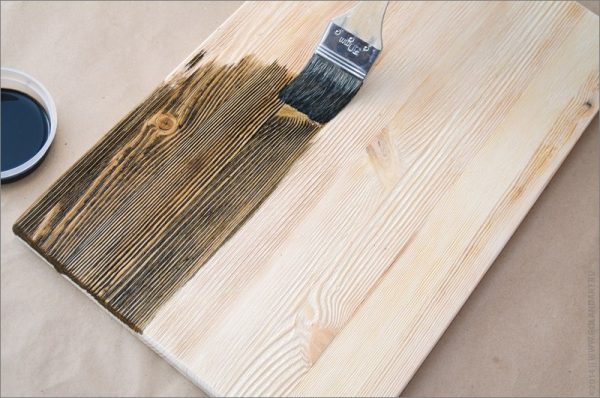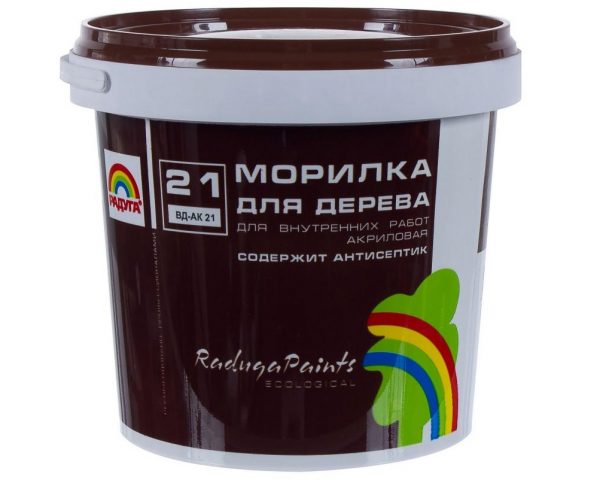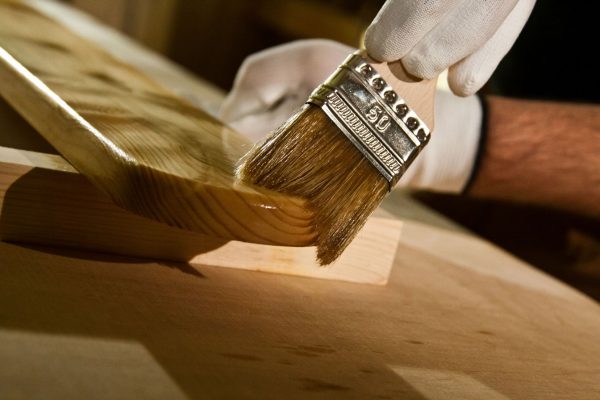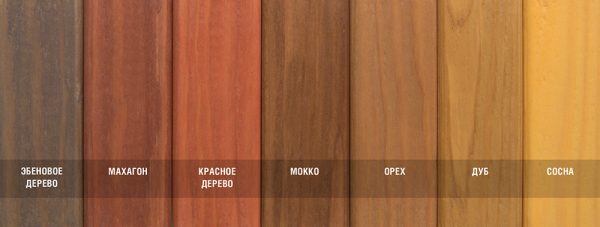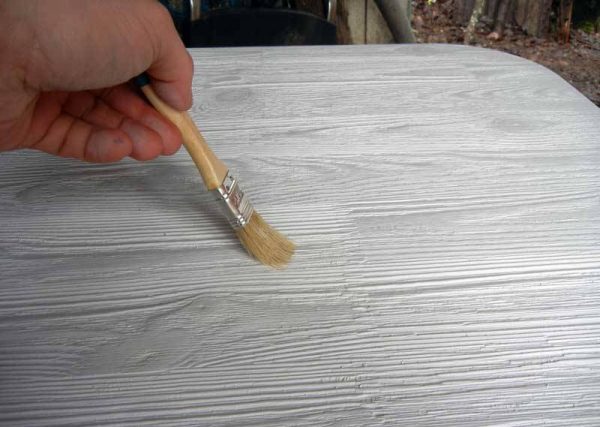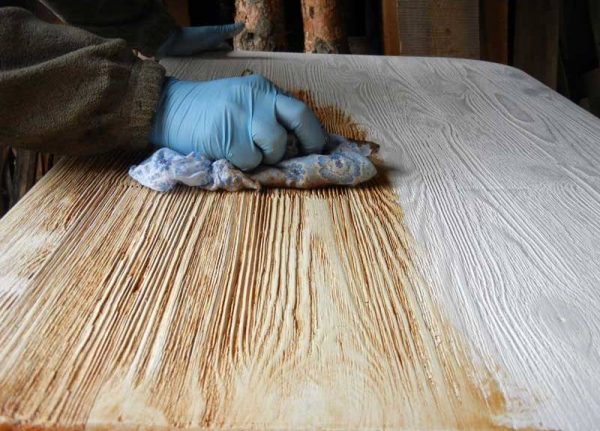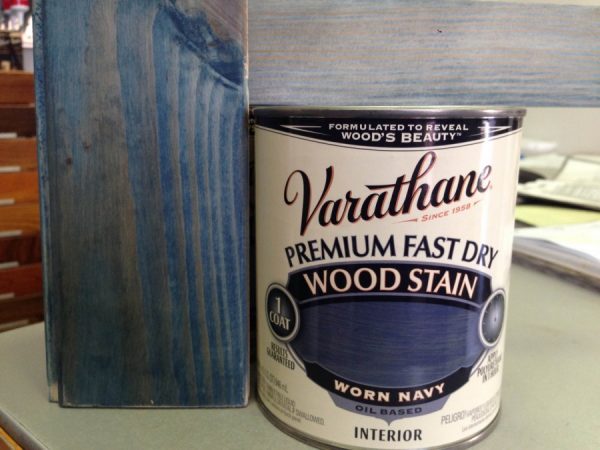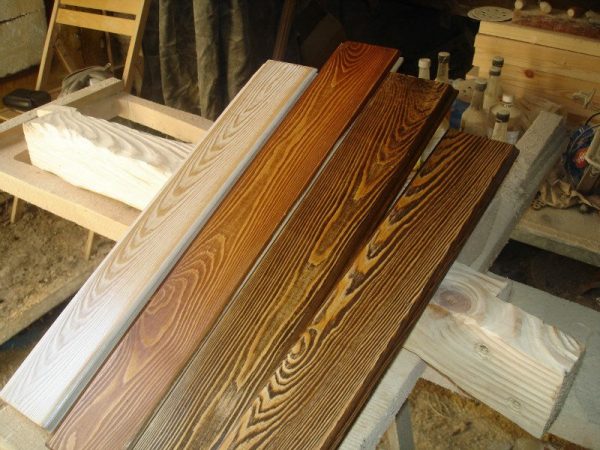Wood stain - a unique tool that is designed to impregnate wood in order to protect it and give an attractive appearance. The palette of shades of such compositions is very diverse: you can find dark, light, golden tones that enhance the basic shade or even completely change it.
- Purpose and composition of stain
- Wood stain colors
- White stain for wood
- Tinting effects
- Whitening process
- Wood aging
- Imitation ebony
- Giving other shades
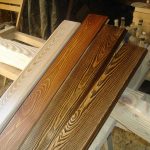
The colors of wood stains most often correspond to natural wood, but there are also rather unusual colors on sale.
to contents ↑Purpose and composition of stain
Stain (stain) is a solution of a special pigment that has coloring, protective, antiseptic properties and is intended for woodwork. If the use of paints and varnishes mainly has a decorative purpose, then the use of stains is for several purposes. This etching material has the following effects:
- protects the tree from decay, which inevitably occurs when moisture gets in, the appearance of woodworms;
- changes the appearance of the material - gives a certain color, helps simulate a more expensive breed;
- restores old surfaces, whitens and tones them;
- prepares wood for further processing;
- gives expressiveness to wood structure, at the same time strengthens layers;
- increases moisture resistance and overall service life of the material.
When choosing a stain, you must take into account its composition. Solutions are based on different components, so some properties are more pronounced than others. All stains are divided into the following types:
- Water based. The most inexpensive and popular formulations, they are in the catalog of any manufacturer of similar products. The color scheme of wood stains for this type of tree is also the most extensive, but includes only natural wood shades. Such products are environmentally friendly, able to penetrate deeply into the structure of the tree, are easily washed off before drying. Most often they are used to enhance the natural color and pattern of the material. Cons of water stains - a long drying period, the need for subsequent grinding of wood due to the rise of fibers, low moisture resistance.
- Alcohol based. Such compositions are quick-drying, but it is more difficult to work with them, because achieving uniformity of application is not easy. Most often, there are oils in the composition of stains, which, when improperly performed, leave ugly spots. But such means provide high protection against ultraviolet radiation, seriously increase the moisture resistance of the material, so they are preferable for bases operated on the street. Many of the alcohol stains are colored because they contain unusual, bright aniline colors: you can find blue, pink, green and other tones. You need to breed stains with white spirit.
- Acrylic and wax. They are the most modern versions of such tools. Their advantages are the formation of a beautiful coating, the ability to tint in any color, giving water-repellent properties. Due to the increased wear resistance, acrylic and wax stains can be used for impregnation of floor coverings. They dry quickly, are completely safe for health.Wax stains are often applied to other types of wood stains to improve the operational and aesthetic characteristics of the tree.
Rustic stains are a separate line. Their composition can be any, but the effect is original. After applying the funds, you can create a game of several shades on the treated area. Before starting work with any stain, it is necessary to conduct a color test: take a wood sample, apply a couple of strokes, let the product dry. Often, the finished shade differs from the intended one, so you have to choose a new tool.
to contents ↑Wood stain colors
On sale there are a huge number of shades of wood stains. It is best to pick them up after testing on a specific material, but this is not always possible. In this situation, you need to look at the name of the tone, because the manufacturer is obliged to indicate the color according to the international classification. However, even identical colors by different manufacturers may produce different effects. On new raw wood, the stain does not look the same as on boards that have been in use for a long time.
The darkest stains are most often used - they give the wood the most noble appearance. With them, even larch, maple will resemble an oak board. Colorless stains are also in demand, which retain a natural shade, but fully provide protective properties.
The most popular are the colors of the stain:
- pine - a light coating, almost no different from natural;
- oak - a very beautiful dark brown tone;
- bleached oak - an interesting color with full preservation of the structure of the tree;
- stained oak (gray stain) - a matte finish with a grayish tint, which must be protected with varnish;
- ebony - gives the effect of artificial aging, "living sex" with the allocation of each knot;
- walnut - is light, medium, dark like wood of the same name;
- mahogany - a noble shade, often applied to tables and chairs;
- mahogany - an elegant dark shade with a red glow;
- wenge - dark chocolate color, spectacular, providing an "expensive" look to the wood;
- Cherry - a popular tone, it is dark and light, the latter is used as a protective coating, since it almost does not change the main color of the tree;
- mountain ash - a pale beige color that needs to be applied 2-3 times;
- ash - leaves the original appearance of the tree, emphasizing its structure, with repeated application gives a pleasant pinkish tint;
- plum - an interesting dark pink tone.
Also popular colors of wood stains are rosewood, alder, teak, marigold, olive and many others. Modern Bayers are able to give wood the most unusual shade, although bright colors are less in demand than natural ones. Of those that are in demand, the following types of wood stains should be indicated:
- black - provides a sense of antiquity, also used for painting ship hulls;
- fern - green stain, it is ideal for children's furniture;
- mocha - gives the color of freshly brewed coffee;
- Oregon - paints a tree in a dark red shade, very saturated and bright;
- lemon - a beautiful yellow tint, to enhance the tone applied in 2 layers;
- hazelnuts - looks like the shell of the corresponding nut.
The color intensity of the stain will directly depend on the type of wood on which it is applied. It is much easier to darken the initially dark color of wood than to give a rich shade to light material.
to contents ↑White stain for wood
White furniture always looks stylish and fresh. To lighten the surface, it is not necessary to use paint, it is enough to purchase a special bleaching stain.It will make the product much lighter and emphasize its structure. In parallel, the product will protect the wood from the effects of adverse environmental conditions. If the item will be used outside buildings, it is better to choose stains with high water-repellent properties, for example, acrylic. For dry rooms, a water-based stain is suitable.
to contents ↑White furniture or flooring painted with such products will visually expand the room. Treated with lightening agents, it is also possible to finish the walls in order to achieve aging, which is very popular in vintage styles.
Tinting effects
Depending on the palette of shades used, such as stains and the desire of the master, you can give the wood a variety of effects. Due to the latest design possibilities are seriously expanding.
Whitening process
White color is very popular in the interior. In addition, with the help of bleaching, you can restore the normal appearance of old wood, which has lost its attractiveness, but has found dark, cyanotic spots. You can also decorate some elements of the interior, for example, cover the frames of photos and paintings with a bleaching stain.
Embossed white products look beautifully, which are treated with special brushes (this removes too soft fibers). After processing, they are covered with a white, light nut stain. To protect the tree from atmospheric factors, white wax can be applied on top.
to contents ↑
Wood aging
An interesting option for finishing wood is to give it an aging effect. First, the product must be prepared: remove dirt, sand, brush off the dust. Then, a wood-based stain of white or other light color is applied to the wood. Freshly applied mixture with a sponge is removed from some areas with smears. After drying, a finish coating based on organic solvents is necessary, and to fix the shade, the pores are filled with shellac primer or varnish on wood.
to contents ↑In addition to this method of giving aging to a tree, there is another popular method. First you need to apply a white stain, after drying, sand the product, then gently rub the dark wax. This will enhance the impression of a large “age” of the coating and bring it closer to the shade of “bleached oak”.
Imitation ebony
For this purpose, dark stains are used, on which there is a corresponding mark. Preliminary carry out grinding and polishing of wood to achieve maximum aesthetic effect. Then put the stain, performing one or two layers. To make the surface resemble a black mirror with manifesting knots, you need to choose the hardest, densest, finest porous rocks.
Giving other shades
Depending on the style, features of the interior or landscape, you can give a variety of colors to wood structures. It is only important that they all fit together well and not conflict. Of the "non-wood" shades, the following are most often used:
- blue - sometimes used as the main coating of finished products, furniture, gives them a very expressive look, goes well with white and yellow tones;
- gray - used in combination with bright accents, otherwise the product will be faceless; with an abundance of gray in the interior there is a risk of depression;
- red - helps to highlight one or more elements from the total mass.
Some try to save and color the wood on their own. Instead of stains, onion husks, alum, infusion of walnuts and other “folk remedies” are used. Unfortunately, the effect is rarely persistent, therefore it is better to purchase a high-quality composition that will last a long time and without complaints.

